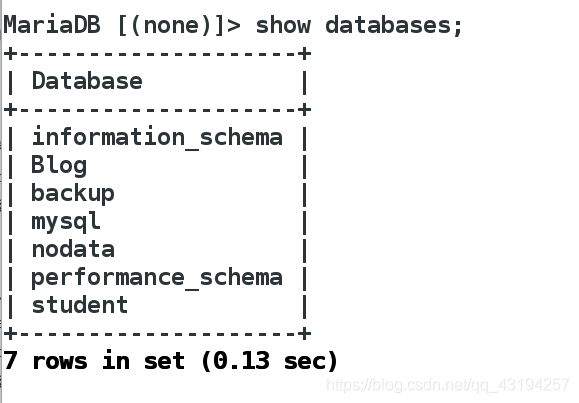01_数据库的安装和使用
# 安装
- yum install mariadb-server.x86_64
# 设置密码
- mysql_secure_installation
# 登陆mysql
- mysql -uroot -predhat -hlocalhost #-u(用户) -p(密码) -h(什么身份登陆)

# 查看所有的数据库
- show databases;
# 创建和删除数据库
- create database hello;
- drop database hello;


# 进入某个数据库并查看所有的数据表
- use Blogl;
- show tables;
# 创建和删除数据表
- create table python(id varchar(50),name varchar(50),age int); #括号内为表头
- drop table python;


# 查看表结构和数据
- desc student;
- select * from student;


# 在数据表中插入和删除表头
- alter table student add id varchar(50);
- alter table student drop id;


# 在数据表中插入和删除数据
- insert into student values('hello',10,60.5);
- delete from student where name='hello';
- insert into student values('hello',10,60.5) default charset=utf8; # 编码格式为utf-8,支持中文
- create table if not exists employee(id varchar(50), name varchar(50), age int) default charset=utf8;# 如果表不存在则创建表,如果存在则不操作

# 找回root用户的密码
- 关闭mariadb服务:systemctl stop mariadb.service
- 跳过授权表:mysqld_safe --skip-grant-table &
- 进入数据库:mysql
- 更新授权表中的root用户的密码:update mysql.user set Password=password('westos') where User='root';
- 退出数据库并查看所有mysql相关的进程:ps aux | grep mysql
- 结束跳过授权表的这个进程:kill -9 pid(跳过授权表的进程pid号)
- 开启mariadb服务
02_python连接数据库
安装第三方软件来建立python和数据库的连接
-python2-------》MySQL-python.x86_64
yum install MySQL-python.x86_64
-python3-------》pymysql
# 用pip下载,yum源中没有该软件包
pip install pymysql
import pymysql
# 1. 连接数据库,
conn = pymysql.connect(
host='localhost',
user='root',
password='westos',
db='helloTest',
charset='utf8',
# autocommit=True, # 如果插入数据,, 是否自动提交? 和conn.commit()功能一致。
)
# ****python, 必须有一个游标对象, 用来给数据库发送sql语句, 并执行的.
# 2. 创建游标对象,
cur = conn.cursor()
# 3. 对于数据库进行增删改查
# 1). ************************创建数据表**********************************
try:
create_sqli = "create table hello (id int, name varchar(30));"
cur.execute(create_sqli)
except Exception as e:
print("创建数据表失败:", e)
else:
print("创建数据表成功;")
finally:
# 4. 关闭游标
cur.close()
# 5. 关闭连接
conn.close()

import pymysql
# 1. 连接数据库,
conn = pymysql.connect(
host='localhost',
user='root',
password='westos',
db='helloTest',
charset='utf8',
# autocommit=True, # 如果插入数据,, 是否自动提交? 和conn.commit()功能一致。
)
# ****python, 必须有一个游标对象, 用来给数据库发送sql语句, 并执行的.
# 2. 创建游标对象,
cur = conn.cursor()
# 3. 对于数据库进行增删改查
# 2). *********************插入数据****************************
try:
insert_sqli = "insert into hello values(2, 'fensi');"
cur.execute(insert_sqli)
except Exception as e:
print("插入数据失败:", e)
else:
# 如果是插入数据, 一定要提交数据, 不然数据库中找不到要插入的数据;
conn.commit()
print("插入数据成功;")
finally:
# 4. 关闭游标
cur.close()
# 5. 关闭连接
conn.close()

import pymysql
# 1. 连接数据库,
conn = pymysql.connect(
host='localhost',
user='root',
password='westos',
db='helloTest',
charset='utf8',
# autocommit=True, # 如果插入数据,, 是否自动提交? 和conn.commit()功能一致。
)
# ****python, 必须有一个游标对象, 用来给数据库发送sql语句, 并执行的.
# 2. 创建游标对象,
cur = conn.cursor()
# 3. 对于数据库进行增删改查
# 3). *********************插入多条数据****************************
try:
info = [(i, "westos%s" %(i)) for i in range(100)]
# *********************第一种方式********************
# # %s必须手动添加一个字符串, 否则就是一个变量名, 会报错.
# insert_sqli = "insert into hello values(%d, '%s');"
# for item in info:
# print('insert语句:', insert_sqli %item)
# cur.execute(insert_sqli %item)
# *********************第二种方式********************
insert_sqli = "insert into hello values(%s, %s);"
cur.executemany(insert_sqli, info )
except Exception as e:
print("插入多条数据失败:", e)
else:
# 如果是插入数据, 一定要提交数据, 不然数据库中找不到要插入的数据;
conn.commit()
print("插入多条数据成功;")
finally:
# 4. 关闭游标
cur.close()
# 5. 关闭连接
conn.close()

import pymysql
# 1. 连接数据库,
conn = pymysql.connect(
host='localhost',
user='root',
password='westos',
db='helloTest',
charset='utf8',
# autocommit=True, # 如果插入数据,, 是否自动提交? 和conn.commit()功能一致。
)
# ****python, 必须有一个游标对象, 用来给数据库发送sql语句, 并执行的.
# 2. 创建游标对象,
cur = conn.cursor()
# 4). **************************数据库查询*****************************
sqli = "select * from hello;"
result = cur.execute(sqli) # 默认不返回查询结果集, 返回数据记录数。
print(result)
# cur的查询方式和文件读取方式类似
# 都是通过指针来确定查询的位置
print(cur.fetchone()) # 1). 获取下一个查询结果集;
print(cur.fetchone())
print(cur.fetchone())
print(cur.fetchmany(4)) # 2). 获取制定个数个查询结果集;
# 4. 关闭游标
cur.close()
# 5. 关闭连接
conn.close()

03_获取表的字段名和信息
import time
import pymysql
# 1. 连接数据库,
conn = pymysql.connect(
host='localhost',
user='root',
password='westos',
db='helloTest',
charset='utf8',
# autocommit=True, # 如果插入数据,, 是否自动提交? 和conn.commit()功能一致。
)
# ****python, 必须有一个游标对象, 用来给数据库发送sql语句, 并执行的.
# __enter__, __exit__
# with语句实现的效果是: with语句执行结束, 如果成功, 则提交改变的数据, 如果不成功, 则回滚.
with conn:
# ****** 判断是否连接?
print(conn.open) # True
# 2. 创建游标对象,
cur = conn.cursor()
# 3).
sqli = "select * from hello;"
result = cur.execute(sqli) # 默认不返回查询结果集, 返回数据记录数。
# 显示每列的详细信息,是一个元组
des = cur.description
print("表的描述:", des)
# 获取表头
print("表头:", ",".join([item[0] for item in des]))
cur.close()
conn.close()
print("with语句之外:", conn.open) # False

04_基于mysql数据库银行转账功能实现
import pymysql
# 在python2中需要安装MySQL-python.x86_64
# import MySQLdb as pymysql
class TransferMoney(object):
# 构造方法
def __init__(self, conn):
self.conn = conn
self.cur = conn.cursor()
def transfer(self, source_id, target_id, money):
# 1). 判断两个银行卡号是否存在?
# 2). 判断source_id是否有足够的钱?
# 3). source_id扣钱
# 4). target_id加钱
if not self.check_account_avaialbe(source_id):
raise Exception("账户不存在")
if not self.check_account_avaialbe(target_id):
raise Exception("账户不存在")
if self.has_enough_money(source_id, money):
try:
self.reduce_money(source_id, money)
self.add_money(target_id, money)
except Exception as e:
print("转账失败:", e)
self.conn.rollback()
else:
self.conn.commit()
print("%s给%s转账%s金额成功" % (source_id, target_id, money))
def check_account_avaialbe(self, acc_id):
"""判断帐号是否存在, 传递的参数是银行卡号的id"""
select_sqli = "select * from bankData where id=%d;" % (acc_id)
print("execute sql:", select_sqli)
res_count = self.cur.execute(select_sqli)
if res_count == 1:
return True
else:
# raise Exception("账户%s不存在" %(acc_id))
return False
def has_enough_money(self, acc_id, money):
"""判断acc_id账户上金额> money"""
# 查找acc_id存储金额?
select_sqli = "select money from bankData where id=%d;" % (acc_id)
print("execute sql:", select_sqli)
self.cur.execute(select_sqli) # ((1, 500), )
# 获取查询到的金额钱数;
acc_money = self.cur.fetchone()[0]
# 判断
if acc_money >= money:
return True
else:
return False
def add_money(self, acc_id, money):
update_sqli = "update bankData set money=money+%d where id=%d" % (money, acc_id)
print("add money:", update_sqli)
self.cur.execute(update_sqli)
def reduce_money(self, acc_id, money):
update_sqli = "update bankData set money=money-%d where id=%d" % (money, acc_id)
print("reduce money:", update_sqli)
self.cur.execute(update_sqli)
# 析构方法
def __del__(self):
self.cur.close()
self.conn.close()
if __name__ == '__main__':
# 1. 连接数据库,
conn = pymysql.connect(
host='localhost',
user='root',
password='redhat',
db='helloTest',
charset='utf8',
autocommit=True, # 如果插入数据,, 是否自动提交? 和conn.commit()功能一致。
)
trans = TransferMoney(conn)
transfer.transfer('03162005','03162008',500)
